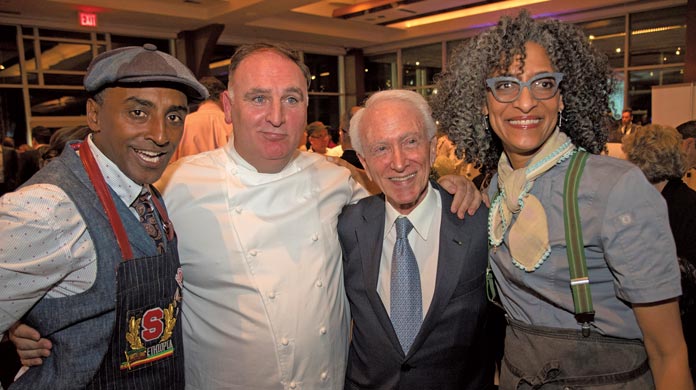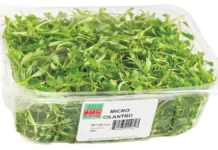
Richard Grausman, educator, author and founder of C-CAP (Careers through Culinary Arts Program) has been involved and an advocate for culinary apprenticeship, education and training for the past 52 years. He takes a stab at forecasting what is to come in the wake of COVID-19, but first a few observations from over the years that might be of interest.
When I started my studies in Paris in 1968, I was fortunate to meet and become friends with Michael Oliver, chef/owner of Bistro de Paris. He was also the son of Raymond Oliver, the chef/owner of Le Grand Véfour and perhaps the most famous chef in France at the time.
They both entertained in their restaurants, and Michael often invited other young chefs over for lunch or dinner and I was lucky at times to be able to join them.
Much of the conversation was centered around some of the things they were doing to counter the problem of getting young workers. Most of them had gotten their training through a culinary apprenticeship (and those interested should read Jacques Pepin’s book The Apprentice) and had worked in large hotels with massive kitchens and staffs.
Recently, however, the young French boys who might have chosen the culinary profession in the past were now choosing to take factory jobs which had better hours and pay.
Hence, the chefs weren’t able to hire enough staff and no one wanted to work the long hours they had become used to.
Because of this problem, they were all finding ways to do things faster and with less prep time. Over the next few years, with the help of food critics Henri Gault and Christian Millau of the restaurant guide Gault et Millau, these chefs became famous for their Nouvelle Cuisine.
Many of their techniques are still used today, but something else happened at that time: Up until Paul Bocuse put his name on his restaurant, most restaurants were not chef- driven.
Diners rarely ever got to see or meet the chef. “My compliments to the chef” was a common expression used to let the chef know you appreciated his food, but it was usually given to the owner of the restaurant as you departed.
Gault et Millau was making the restaurant chef known and famous!
Within the next ten years, things changed. As a result of the success of the “Celebrity Chefs,” young people were again attracted to the kitchen and the Japanese government started paying the French government to cover the salaries and insurance for their young chefs to work in the top French restaurants.
While teaching for Le Cordon Bleu, I would return to France each year to sign a new contract and visit my favorite restaurants as well as hot new ones.
Each year, I noticed the increase in their staffs. By the late 70s and early 80s, the kitchens were crowded with young chefs all trying to learn from the masters.
By this time the simple Nouvelle Cuisine food was becoming more elaborate. Plates were filling up with more items and desserts were made by well-trained pastry chefs, which most restaurants couldn’t afford in the past.
This same ebb and flow of labor has been seen in our restaurants over the past 30 years as well, and the Food Network has done for our chefs what Gault et Millau did for France.
What’s different in the U.S. is that ethnic and regional cooking has really come into its own. Fifty years ago, everyone knew a bit about the French, Italian and Chinese restaurants in their cities, but now there are hundreds of different types of restaurants from every nation in the world.
Then, men cooked in restaurants and women cooked at home. Today you will find women in most of the top restaurants. More and more women are owning their own restaurants and most of the top pastry chefs are now women.
As we work our way to the reopening of our country, after the pandemic, what will the opportunities be for young people who want to enter the culinary industry?
In my early days, teaching for Le Cordon Bleu de Paris, (1969-1985) opportunities for a high school graduate to get a culinary education were extremely rare.
Programs like those at the Culinary Institute of America, Johnson & Wales University and Monroe College were just in their infancy. If you didn’t go to a vocational high school with a culinary program, you started by washing dishes or setting tables, two entry-level jobs that still exist today.
Those lucky enough to start working for large hotels and resorts could participate in formal apprenticeship programs that prepared you well for a career in the kitchen.
In my view, the apprenticeship model was unknowingly dismantled when, in the 1970s or early ‘80s Sheraton Hotels decided to cut their expenses by basically letting their Executive Chefs go and elevating their Sous Chefs to Executive Chefs without the appropriate increase in salary.
By doing this, their overhead was lowered and their bottom line improved, but it changed forever the apprenticeship process that had been in place for decades.
What the decision did, overnight, was to send a message to chefs, that loyalty to one’s employer was no longer valued. Other hotel chains like Marriott followed by cutting staff and outsourcing production.
Kitchens that once made stocks from scratch, butchered their own meat, cut their vegetables, made their own breads, pastries and desserts, now went to smaller staffs and more commercially produced products.
Without the in-house staff to train the apprentices, hotels turned to the budding culinary school industry for their trained labor.
In the past year, during the pandemic, restaurants have closed, and many of the industry’s workers have moved on to other occupations.
As the country reopens there will be a demand for trained workers again. Will we go back to culinary schools for this labor pool or will something new or different take shape?
One thing that has come out of this year of “distance learning” is an abundance of educational and instructional videos, like those from Rouxbe (Masterclass) and the Jacques Pepin Foundation all of which are excellent if you are self-motivated and a visual learner.
There are many colleges around the country, with culinary programs, but there are thousands of students graduating high school who are either not interested or ready to attend college.
For them and the industry, a new form of apprenticeship might be the best way to train new workers.
At C-CAP, we have always provided scholarships to higher education (totaling $62 million since we were founded) but we also believe that if we can provide basic training to high school teachers and their students, making them of value to the industry, the industry should be willing to continue these students training on the job, just like they used to do in France.
Recently, we have found many chefs who have worked with our graduates in the past, interested in hiring committed students to train and retain as good and loyal workers.
Investing in their futures is one way to do that. At its heart, C-CAP is a workforce development nonprofit committed to apprenticeships.
We are planning to become a Registered Apprenticeship Program with the Department of Labor’s Office of Apprenticeship. And we’ve already created a myriad of multi-sectoral partnerships with companies like Sodexo and large and small restaurant groups.
Finally, our new Earn to Learn Apprenticeship will be a grant-funded program, whereby our students are paid to apprentice, especially with those independent restaurateurs in lower-economic communities who were severely economically impacted by the pandemic.
Our students get paid and experience, our chefs get free trainees. It’s a win-win.
Motivating young people to enter an industry that requires hard work and long hours has always been a challenge, but with the government spending money to develop new industries with higher paying jobs, the hospitality industry will face the same lack of labor the French chefs faced in the late 1960s.
Raising entry-level wages, providing health insurance, vacation time and offering career training are things the industry needs to do to attract a new generation of dedicated and talented workers. And I think it starts with C-CAP.























